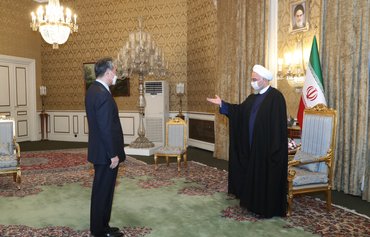Reports from Iran over the past few weeks and months of slowed down internet speeds and intermittent outages suggest the regime may be trying to tamp down on a new round of civil unrest.
For more than a decade, the Islamic Republic has regularly restricted its citizens' access to the internet, slowed down web traffic, jailed online activists and used web-based location tracking tools to crack down on protests.
Iran's telecommunications industry is in large part controlled by the Islamic Revolutionary Guard Corps (IRGC), which, through its cybercrime unit, has been cracking down on internal dissent for over 10 years.
For instance in late 2019, amid widespread protests in response to a sudden tripling of petrol prices, internet access was totally disrupted for several days. Later, authorities allowed access but connectivity was limited for weeks after.
![Tens of thousands of Iranians took to the streets in January 2020, demanding the regime's top leaders resign. [File]](/cnmi_di/images/2021/01/06/27839-iranprotests-600_384.jpg)
Tens of thousands of Iranians took to the streets in January 2020, demanding the regime's top leaders resign. [File]
Fear of unrest
"Internet speeds are intentionally kept low," said Nazanin Mashhadi, an Iran-based architect.
"Ostensibly, we are paying for high-speed internet, but they cap the speeds," she said. A WhatsApp video call froze during her remarks for this article late at night Tehran time.
That is not unusual, she said, noting that it happens "because they throttle the connection".
Acknowledging intermittent slowness and outages, regime officials say the throttling of internet speed is aimed at slowing the flow of "immoral content", including pornography or other sexually suggestive material, into the country.
However, data from non-governmental organisation NetBlocks, which monitors freedom of access to the internet, indicates that the primary driver behind restricting internet speeds in Iran is the regime's fear of social unrest and protests.
"The information vacuum continues to limit human rights monitoring and coverage of incidents on the ground," NetBlocks said at the time.
Shortly after Iran throttled the internet and blocked popular messaging apps, the US Treasury imposed sanctions on Mohammad-Javad Azari Jahromi, Iran's Minister of Communications and Information Technology, for advancing Iran's policy of internet censorship.
Treasury Secretary Steven Mnuchin issued a statement, saying, "Iran's leaders know that a free and open internet exposes their illegitimacy, so they seek to censor internet access to quell anti-regime protests."
'Futile effort'
On July 16, 2020, NetBlocks reported that authorities in Iran's Arab-majority Khuzestan province sharply reduced internet speeds amid protests against the Islamic Republic's foreign policy and dire domestic economic conditions.
In December 2020, authorities slowed internet speeds after Iranians began posting memories of the 2019 protests online -- including instances of protesters being shot by the IRGC and security forces.
"It is a futile effort; a representation of the same censorship policies that the Islamic Republic has been pursuing for the past few decades," said a US-based former Iranian naval analyst, who spoke on condition of anonymity.
Comparing the regime's efforts to restrict internet access to its early efforts at redacting material in English-language news magazines in circulation in Tehran, he said, "Officials think they can make reality disappear by restricting access to information."
This only undermines the credibility of the authorities, especially in this day and age, when there are so many avenues to find things out in real time, he said.
Double standard
Even as the Islamic Republic cracks down on protesters for using social media and the internet to document repression against citizens, regime officials use it to spread their own propaganda.
Foreign Minister Mohammad Javad Zarif, President Hassan Rouhani and even Supreme Leader Ali Khamenei all use Twitter regularly, just to name a few.
Among all Iranian officials on Twitter, Zarif is the most active, appears to have the largest audience and receives the most reactions to his tweets, most of which are posted in English.
"Zarif's main task is to cover up the true face of the Islamic Republic in the world, and he is carrying out the task very openly on Twitter," said Tehran-based journalist Mina Bashiri.
For instance, Bashiri said, "he tweets about human rights in Iran. He defends the regime and says human rights are not violated and religious minorities are not suppressed in Iran".
These assertions fly in the face of recent evidence.
This double standard angers the public, who have been using VPNs -- or what is referred to as "filter-breaker" -- for several years to overcome the hurdles the regime creates by restricting their access to the internet.
Through this technology, most Iranians are able to access many of the internet sites they desire, even if that means paying more money for it.

![Iranian protesters gather around a fire during a demonstration in Tehran in November 2019. [AFP]](/cnmi_di/images/2021/01/06/27838-000_1mb8wk-600_384.jpg)







Stop lying
Reply3 Comment(s)
A very enlightening article. Keep up the good work.
Reply3 Comment(s)
I have downloaded a large number of movies since this morning at six megabytes per second. I am in the northwest of Tehran. The internet speed has not slowed down at all.
Reply3 Comment(s)